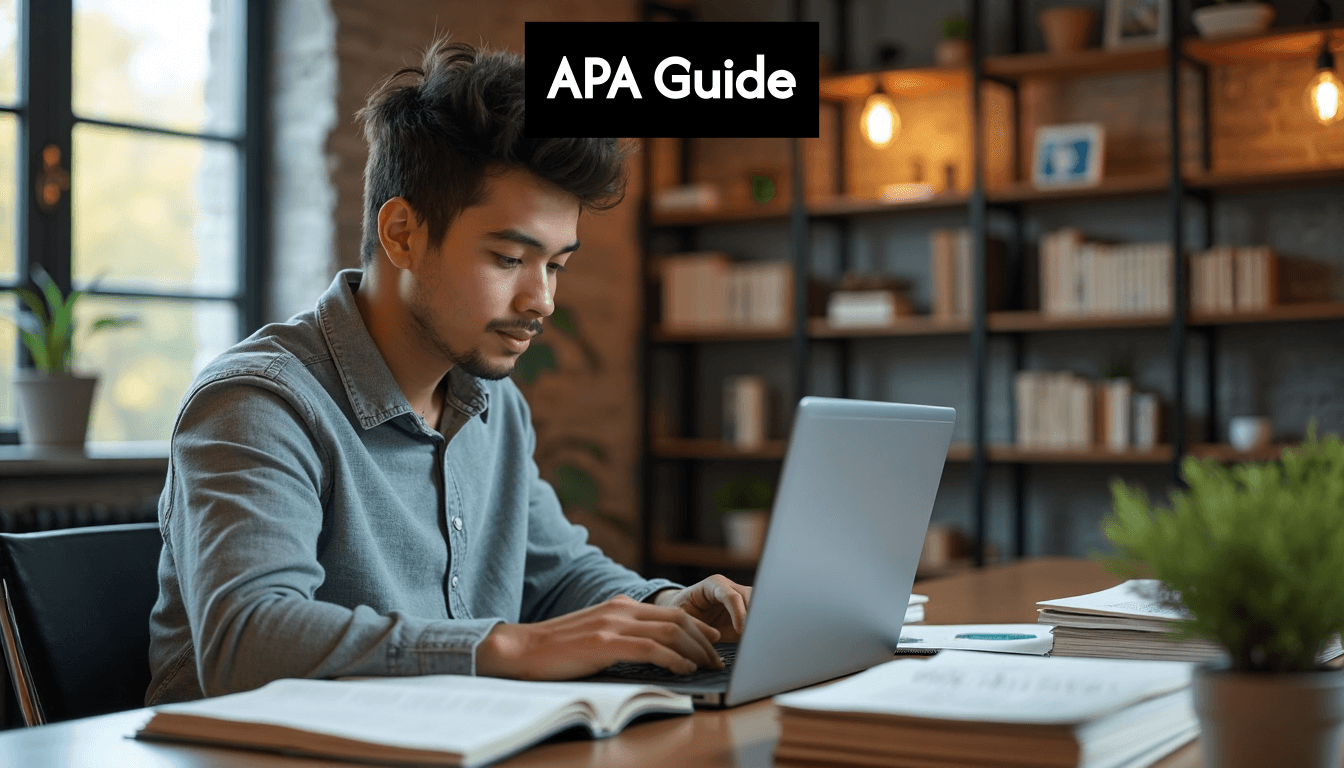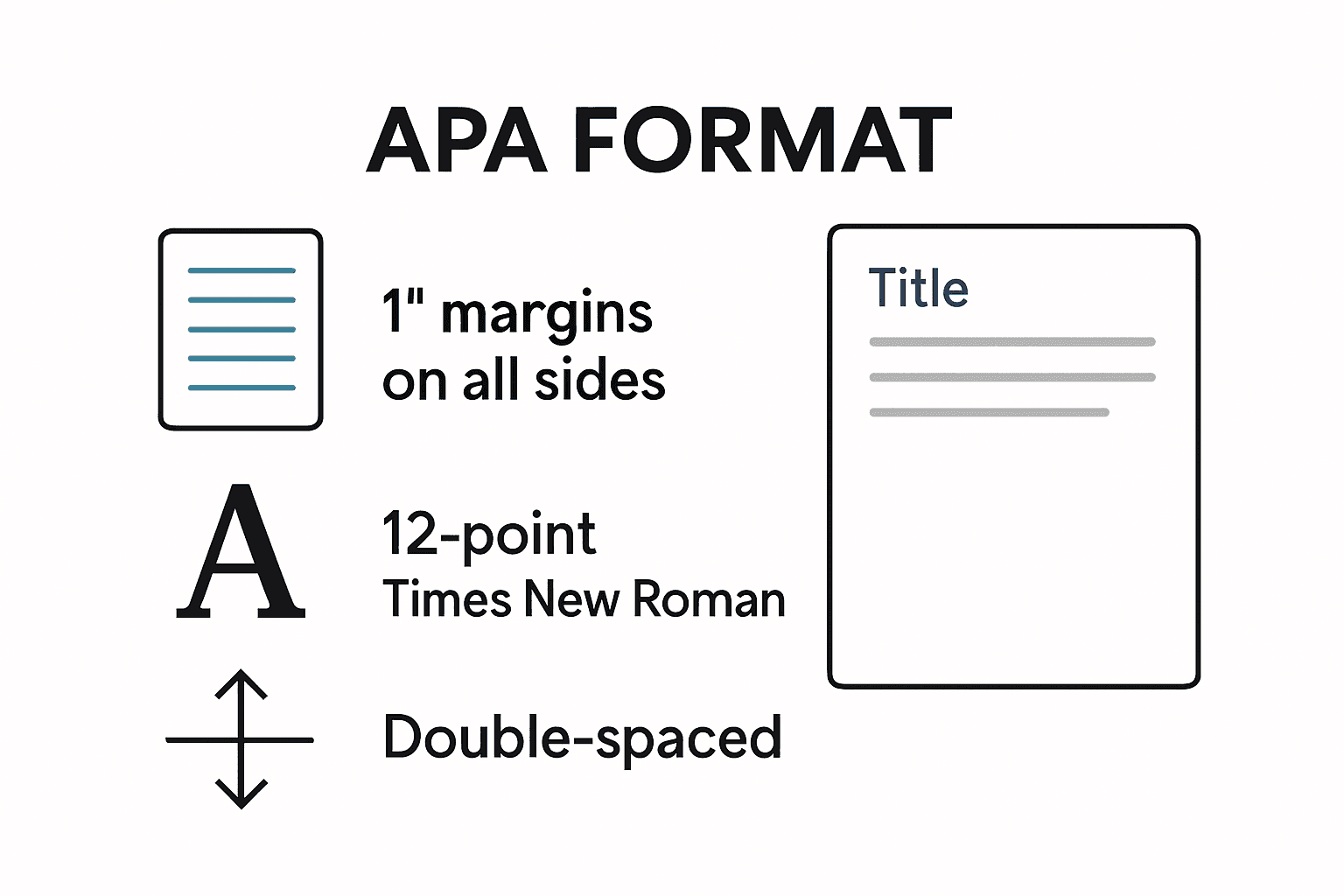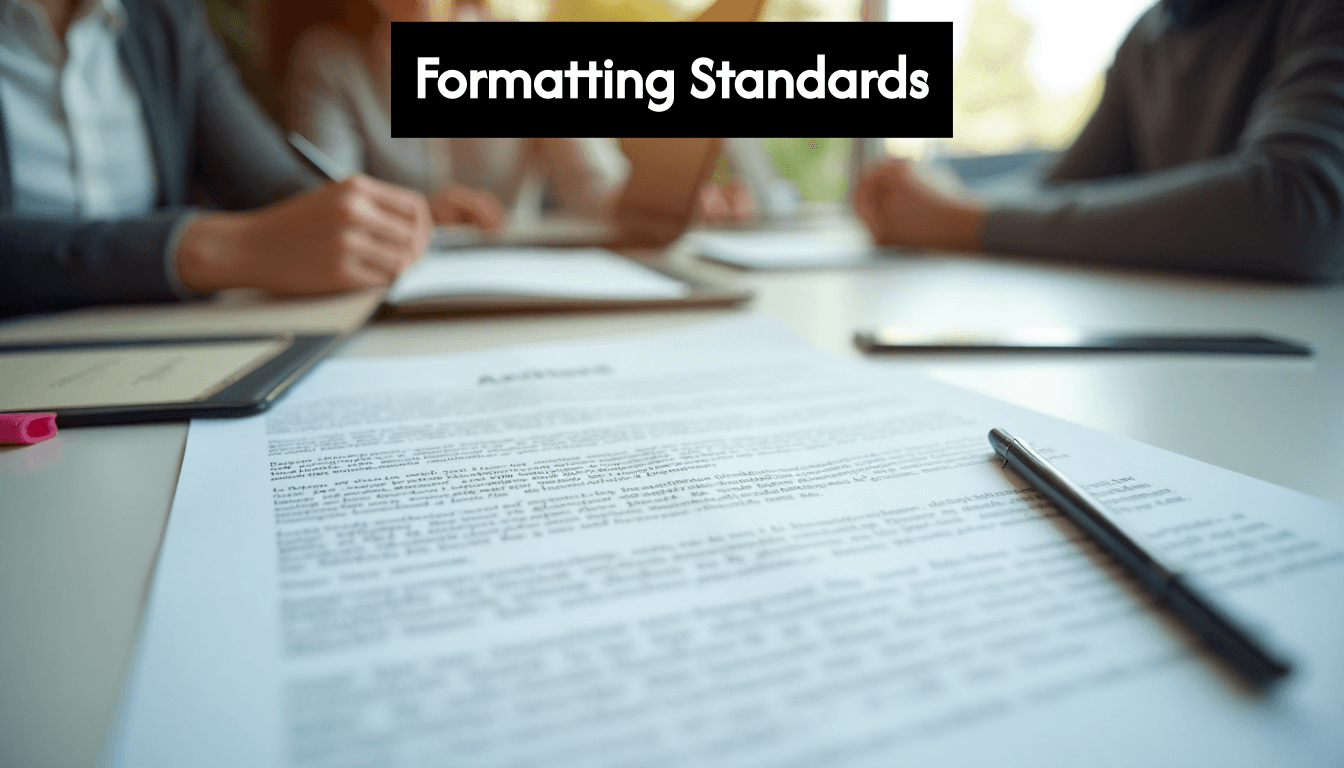Blog
Learning Materials
APA Format Student Paper Guide 2025: Easy Steps for Success
Updated: June 13, 2025

Staring at a blank page with APA formatting rules looming overhead can feel overwhelming for any student. Yet here’s what most people miss. Nearly 60 percent of students lose points due to simple formatting errors like incorrect margins or faulty citations. That stat sounds discouraging, right? Surprising fact, following a few clear steps instantly transforms that frustration into a polished submission. The secrets behind flawless APA papers are much simpler than you think.
Table of Contents
- Core Document Formatting Standards
- Structural Requirements For Academic Papers
- Citation And Reference Guidelines
- Choosing The Right Document Foundations
- Constructing The Title Page
- Page Numbering And Header Configurations
- Mastering Headings And Structural Organization
- Citation And Reference Precision
- Common Formatting Pitfalls To Avoid
- Citation And Reference Inconsistencies
- Formatting And Structural Errors
- Capitalization And Punctuation Pitfalls
Quick Summary
| Takeaway | Explanation |
|---|---|
| Core Formatting Standards | Use standard white paper (8.5" x 11"), with 1-inch margins, and select accessible fonts like Times New Roman (12-point) or Arial (11-point). |
| Structured Paper Format | An APA paper typically includes a Title Page, Abstract, Main Body with headings, and References. Ensure double-spacing and correct paragraph indentation. |
| Citation Accuracy | In-text citations require the author's last name and publication year, while reference lists must follow specific hanging indent formatting. |
| Avoiding Common Errors | Double-check for consistent double-spacing, correct font usage, proper margin settings, and accurate page numbering to maintain APA credibility. |
| Attention to Detail | Each element of your document, from headings to punctuation, requires meticulous review to convey professionalism and adherence to academic standards. |
Understanding APA Format Requirements
Mastering APA format is crucial for academic success, whether you're writing a research paper, term paper, or dissertation. The American Psychological Association (APA) style provides a standardized approach to academic writing that ensures clarity, consistency, and proper attribution of sources.
Core Document Formatting Standards
APA format demands precision in document setup. You'll need to use standard white paper (8.5" x 11"), with 1-inch margins on all sides. Typography matters significantly select an accessible font like Times New Roman in 12-point size, or Arial in 11-point. Learn more about precise formatting techniques to ensure your document meets professional academic standards.

Every page requires a consistent header that includes the paper's title in uppercase letters, aligned to the left margin. Page numbers should appear in the top right corner of each page. This systematic approach creates a clean, professional appearance that allows readers to focus on your content rather than getting distracted by formatting inconsistencies.
Structural Requirements for Academic Papers
The typical APA student paper follows a specific structural framework. Your document will typically include:
- Title Page: Centered information including paper title, your name, institutional affiliation, and submission date
- Abstract: A concise summary (150-250 words) highlighting your paper's key points
- Main Body: Structured sections with clear headings and subheadings
- References: A comprehensive list of all sources cited in the paper
Paragraph formatting requires double spacing throughout the entire document. Each paragraph should be left-aligned with a clear, consistent indent at the first line. This creates visual consistency and improves readability.
Citation and Reference Guidelines
Accurate citations are the cornerstone of APA format. In-text citations must include the author's last name and the publication year. For direct quotes, you'll also need to include the specific page number. The APA 7 Citation Guide provides comprehensive details on proper citation methods.
Reference entries follow a specific hanging indent format, where the first line is flush left and subsequent lines are indented. Each reference must include detailed publication information, allowing readers to easily locate the original source.
Understanding these requirements might seem complex, but with practice, APA formatting becomes second nature. Pay attention to details, use consistent formatting, and always double-check your work against the latest APA style guidelines. Proper formatting not only demonstrates academic professionalism but also ensures your research is presented with maximum clarity and credibility.
Step-by-Step APA Student Paper Setup
Navigating the APA student paper setup requires attention to detail and a systematic approach. This comprehensive guide will walk you through each critical step to ensure your academic document meets professional standards.
Choosing the Right Document Foundations
Begin with the fundamental technical requirements. Select a standard white 8.5" x 11" paper and set up your document with precise margins. Ensure 1-inch margins on all sides create a clean, professional appearance. For typography, choose an accessible font like Times New Roman (12-point) or Arial (11-point). Explore advanced formatting techniques to refine your document's visual presentation.
Double-spacing is mandatory throughout your entire document. This includes the main text, block quotes, reference list, and any additional sections. Use a 0.5-inch first-line indent for each paragraph to maintain consistent formatting. These seemingly small details significantly impact your paper's overall readability and academic credibility.
Constructing the Title Page
The title page serves as the gateway to your academic work. Center all information vertically and horizontally. Include these essential elements:
- Paper Title: Centered, bold, and written in title case
- Your Name: Centered on the line following the title
- Institutional Affiliation: Centered below your name
- Course Information: Course number and name
- Instructor's Name: Clearly displayed
- Assignment Due Date: Positioned at the bottom of the page
Each element should be double-spaced, creating a clean and organized appearance. Avoid unnecessary decorative elements that might distract from the professional presentation.

Page Numbering and Header Configurations
Page numbers are crucial for navigation and academic tracking. Place them consistently in the top right corner of every page. Your page header should include an abbreviated version of your paper's title in uppercase letters, aligned to the left margin.
For student papers, a running head is no longer required in the 7th edition of APA style. This simplifies your formatting process while maintaining professional standards. Check out our comprehensive citation guide for additional formatting nuances that can elevate your academic writing.
Remember that consistency is key. Each element of your document should follow these guidelines precisely. Take time to review your formatting, checking that margins, spacing, fonts, and page elements align perfectly with APA requirements. While it might seem meticulous, these details demonstrate your commitment to academic excellence and professional presentation.
Practice and attention to detail will transform APA formatting from a challenging task to a natural part of your academic writing process. Each paper you complete will become easier as you internalize these formatting standards.
Essential Tips for Flawless APA Formatting
Mastering APA formatting requires more than understanding basic rules. It demands precision, attention to detail, and a strategic approach to academic writing. This section will reveal advanced techniques to elevate your document from acceptable to exceptional.
Mastering Headings and Structural Organization
APA Style offers a sophisticated hierarchical heading system that helps readers navigate your document efficiently. The 7th edition provides five distinct heading levels, each with specific formatting requirements. Your primary heading should be centered, bold, and written in title case. Subsequent levels progressively shift from bold to standard text, creating a clear visual hierarchy.
When implementing headings, maintain consistency throughout your document. Each section should logically flow into the next, using headings as signposts that guide your reader through your academic argument. Explore advanced formatting strategies to transform your paper's structural clarity.
Use headings strategically to break complex information into digestible segments. Avoid using too many or too few headings. The goal is to create a balanced, readable document that presents your research with professional sophistication.
Citation and Reference Precision
Accurate citations are the backbone of academic integrity. In-text citations must include the author's last name and publication year. For direct quotes, include page numbers to help readers locate the original source. Parenthetical citations should be concise and placed before the punctuation mark.
Your reference list requires meticulous attention. Each entry must follow a specific format with hanging indents, alphabetical order, and comprehensive publication details. Dive into our comprehensive citation guide to understand the nuanced requirements for different source types.
Pay special attention to digital sources. Include DOI (Digital Object Identifier) numbers when available, and ensure you're using the most current publication information. Online sources require additional details like retrieval dates and web addresses.
Common Formatting Pitfalls to Avoid
Several subtle formatting errors can undermine your academic credibility. Double-check these critical areas:
- Spacing: Consistently use double-spacing throughout the entire document
- Font: Maintain a single, professional font at a consistent size
- Margins: Preserve 1-inch margins on all sides
- Page Numbers: Include continuous numbering in the top right corner
Proofreading is not just about content. Spend time reviewing your formatting, ensuring every element aligns perfectly with APA guidelines. Consider using APA formatting tools or having a peer review your document for technical accuracy.
Remember that APA formatting is more than a set of rules. It's a communication method that enhances readability and demonstrates your commitment to academic excellence. Each carefully formatted page reflects your professionalism and attention to scholarly standards.
Practice and patience are your greatest allies. With consistent effort, APA formatting will become second nature, allowing you to focus on the most important aspect of your academic work: your research and ideas.
Common APA Format Mistakes and Solutions
Navigating the intricate landscape of APA formatting can be challenging, even for experienced academic writers. Understanding common mistakes and their solutions is crucial to producing a polished, professional document that meets rigorous academic standards.
Citation and Reference Inconsistencies
One of the most frequent errors in APA formatting involves misalignment between in-text citations and reference list entries. Students often struggle with correctly matching sources cited in the text with their corresponding full references. Learn advanced citation techniques to ensure complete accuracy.
Key citation mistakes include:
- Omitting sources from the reference list
- Incorrect author name formatting
- Missing publication years
- Improper punctuation in reference entries
To resolve these issues, create a comprehensive tracking system. Maintain a working reference list as you write, double-checking that every in-text citation has a corresponding full reference. Cross-reference each source meticulously, ensuring perfect alignment between your text and reference page.
Formatting and Structural Errors
Structural formatting represents another significant challenge for students. Common mistakes include:
- Inconsistent heading levels
- Incorrect font or spacing
- Improper margin settings
- Inconsistent page numbering
Explore expert formatting strategies to streamline your document preparation. Pay special attention to the hierarchical heading system. APA's 7th edition provides five distinct heading levels, each with specific formatting requirements. Maintain consistent capitalization, bolding, and positioning to create a clear visual hierarchy.
Capitalization and Punctuation Pitfalls
Subtle errors in capitalization and punctuation can undermine your academic credibility. Research indicates that many students struggle with correct capitalization in reference titles. According to academic style guides, only the first word of the title, the first word after a colon, and proper nouns should be capitalized.
Punctuation presents another common challenge. Careful attention must be paid to:
- Comma placement in citations
- Period usage in reference entries
- Proper formatting of digital source citations
Proofread meticulously. Consider using multiple review methods:
- Digital APA formatting tools
- Peer review
- Institutional writing center consultations
Remember that APA formatting is more than a set of rules. It's a communication method that demonstrates academic precision and attention to detail. Each correctly formatted page reflects your commitment to scholarly excellence.
Developing proficiency in APA formatting takes time and practice. Approach each document as an opportunity to refine your skills. With consistent effort and careful attention, you'll transform these potential pitfalls into strengths that showcase your academic capabilities.
Frequently Asked Questions
What are the core requirements for APA format?
Core requirements for APA format include using standard white paper (8.5" x 11"), 1-inch margins, and fonts like Times New Roman (12-point) or Arial (11-point). Your document should feature a title page, abstract, main body, and references, all double-spaced with consistent paragraph indentation.
How do I set up my title page in APA format?
Your title page should center the paper title, your name, institutional affiliation, course information, instructor's name, and assignment due date. All elements must be centered and double-spaced, providing a professional appearance.
What common mistakes should I avoid in APA formatting?
Common mistakes include inconsistent margin settings, incorrect citations, improper heading levels, and failure to use double-spacing throughout. Double-check these elements to maintain academic credibility.
How do I format in-text citations in APA style?
In-text citations in APA style require the author's last name and the publication year. For direct quotes, you also need to include the specific page number. Make sure to place the citation just before the punctuation at the end of the sentence.
Say Goodbye to APA Formatting Stress – Experience Effortless Academic Writing Now!
Are you tired of losing points over technical APA details like margins or citations? You have put in the hard work researching and drafting your paper, but formatting errors still stand in the way of a perfect score. Many students feel anxious about missing small requirements such as consistent headers, reference alignment, or hanging indents. If the fear of formatting is holding you back, you are not alone.

Discover how Samwell.ai can simplify your next submission. This advanced platform uses Semihuman.ai technology to help you instantly generate, edit, and refine academic papers while automatically applying the latest APA standards. Boost your confidence with features like real-time AI checks, a Power Editor for precision tweaks, and Guided Essays that keep your structure organized. Ready to protect your grades and overcome formatting worries? Try Samwell.ai today and see how easy it is to turn your research into an APA-perfect document. Start now and make your next paper your best one yet!
Recommended Articles
Generate essays with Samwell.ai
Whether you’re a publisher, professor, journalist, or student, let us tailor a plan just for you.Most Read Articles

Your Guide to Help Writing a Essay Successfully
Expert tips for help writing a essay - from crafting a thesis to structuring your essay effectively.

How to Write Critical Thinking Essay: Expert Tips
Expert tips for writing a critical thinking essay. Learn how to structure, choose topics, and use evidence effectively.'

How to Write a Good Hook: A Step-by-Step Guide
Master the art of crafting a good hook with our guide. Create compelling openers for a memorable first impression.
